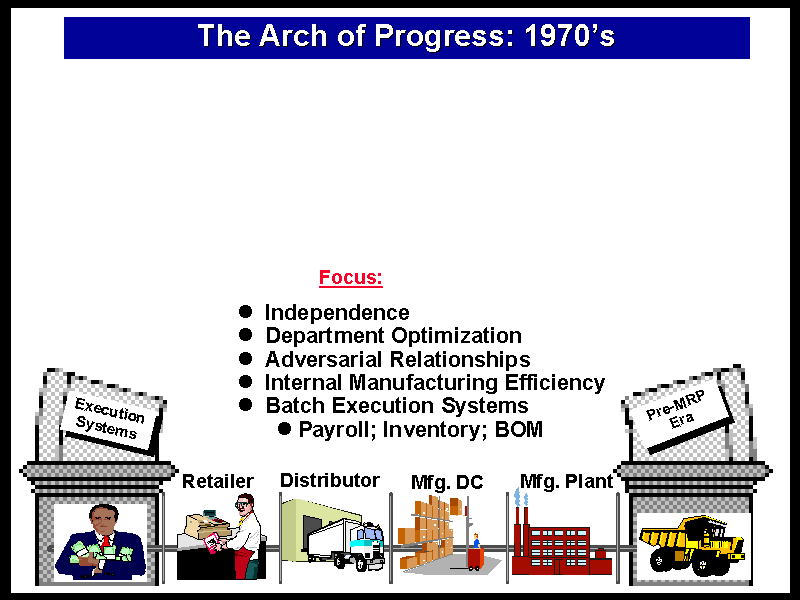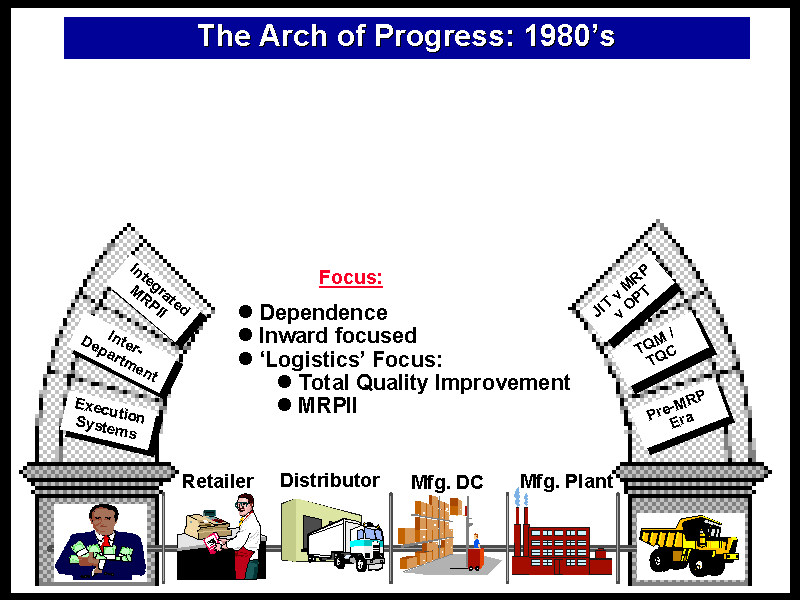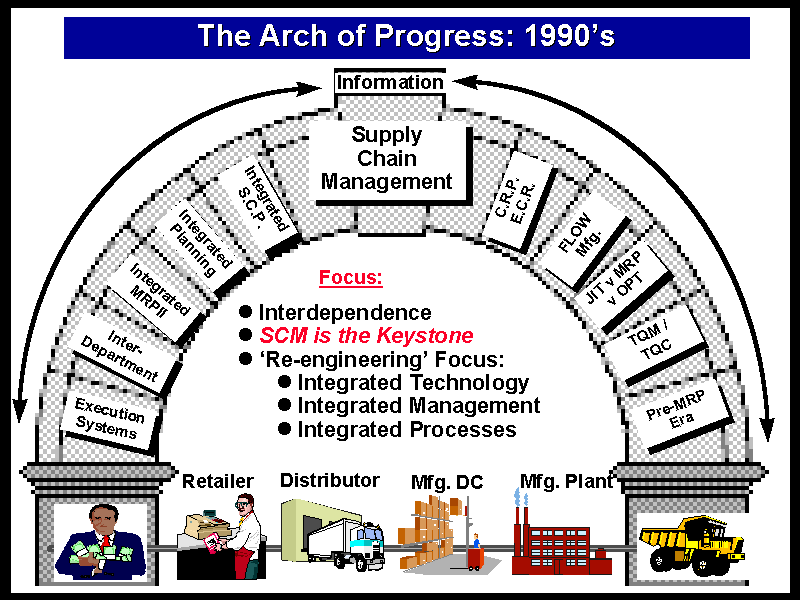
The Arch of Progress
The concept of architecture of computer operating systems is an important one. The fundamentals in the design of such systems must be observed if the hardware is to function efficiently. The same must hold true for the 'operating systems' through which Users seek to benefit from the
software application solutions offered for their problems. It is a little known fact that the Catenarian Arch is the strongest man-made structure since the dawn of time. The St. Louis Gateway Arch for example uses this basic shape. Well, interestingly, this type of arch was conceived of many hundreds of years ago and has not been improved upon since. Clearly a stronger material could be used today to build the Arch, but the design itself has not been improved upon.
In Materials Management, or Logistics, or as it has become known today, Supply Chain Management (SCM), we have been led to believe by management theorists that there are new solutions to old problems. Like the Arch however, we find that there are in fact some basic design features that underpin all that is being espoused today.
Whatever the technique used : Distribution Requirements Planning (DRP):Vendor Managed Inventory (VMI) Quick Response (QR); Continuous Replenishment Planning (CRP), or Retailer Management Replenishment (RMR) as they say in Canada, it makes no difference.
In fact, even if we go so far as to include some other solution acronyms such as...
...we will still find that, whatever the solution used, and whatever technique or management theory is applied, a common theme and three common processes exist.: Planning, Execution and Measurement are the common processes that are always at work - to a greater or lesser extent. The common theme is that the planning process has been typically misunderstood or not effectively utilized.
Over the years we have changed the names, we have changed the terminology, and we have even changed the emphasis - but in general the business benefits attributed to these vital solutions are still only erratically achieved and by a small handful of companies. Why is this? What did we need to change?
To help understand the need, and why there is not an "out of the box" solution, or some golden rule, this paper will use the analogy of the Catenarian Arch to illustrate the building blocks necessary in order for SCM to achieve the goals of reduced inventory, reduced cycle time, and increased customer service levels, and to describe how those blocks can be constructed in the strongest and securest way.
The Arch of Progress describes the evolution of Supply Chain Management.

Back in the 1970's the foundations for today's effective Supply Chain Management were laid.
Unfortunately, the 'learning curve' was painful. Taking the lead from the military,
the term 'logistics' was adopted to represent the movement of product through the supply chain.
In the early days of computerization, financial and measurement control systems were implemented. Typically these systems used standard or average costs as their basis and included Nominal and General ledger functions but as yet no effective Costing programmes were in use. With these types of basic, stand-alone, facilities in place, our systems and solutions were about to evolve.
During the 1970's the typical 'execution' systems were developed. These included the computerized Purchasing and Order entry functions. Very basic, these systems effectively became data access and paper chasers or placeholders. Little attempt was made to introduce real-time events or move beyond data accuracy issues, so the paperwork systems were still the mainstay and forecasting and planning not easily performed. No wonder we couldn't get the Materials Manager to drop his manual "BIN Cards". This period is synonymous with the "pre- MRP", or "Production First" era. Rudimentary manufacturing control was instituted at the end of this period - simple, single level Bills of Material. Single level Product Structures, with no separate inventory allocation feature were standard practice.
During this period the management of the total business was similarly constructed in that corporate business levels and goals were set for overall success, but personal remuneration was typically based upon conflicting departmental goals. Thus the focus for improvement was departmental and hence not synergystic and independent of corporate goals derived from "bottom up" plans. Competitive thrusts for improvement were focused internally - within each department. For example, a department might achieve its own goals and yet the company still fail in its overall goals: success was seen as all departments achieving their own goals - not knowing, or perhaps caring, that many departmental goals were in direct conflict. All external commercial activities were essentially adversarial in their nature.
The intermediate period is as shown in the following diagram:

The "Integrated MRPII" era brought expansion and added complexity in the MRP and other associated
"Execution" systems. Scant regard was paid to the "Planning" systems. The focus was on doing things
faster, quicker and better (efficiency) - not doing things differently (effectively).
As the "pre-MRP" era came to a close, we all headed toward the sunlit uplands of MRPII and, later, JIT. Our weaknesses were overlooked as we reached for the Oliver Wight handbook and implemented our first integrated MPRII package. Didn't we all aspire to "Class A" status like excited graduates heading off towards their glittering new futures? All this -according to the theorists today- was folly. Was it, or was it just a necessary step on the learning curve in adapting the new-found technical resources to our purposes?
The Western world adopted MRPII and the Eastern world espoused the benefits of Just In Time and Total Quality Control. During the late 70's and early 80's the apparent weakness of MRPII when under the onslaught of the JIT and TQC programs was underscored by small trade wars and continued and increased allegations of "dumping". Reams of papers were published matching MRP to JIT: "Was it a fair contest?". In fact, MRP and JIT, as we now know today, are quite separate and different processes. They can in fact coexist in a strange sort of way - depending on how you define them, of course.
The focus now shifted somewhat from departmental and independence to inter-departmental and dependency. Management lurched from crisis to crisis, in the deficient belief that corporate success now relied on reconciling departmental goals. Most of us can still remember that first tentative meeting between the CEO, Head of Purchasing and Head of Manufacturing.
The poor CEO knew full well he had to get synergy between departments, but the tools and techniques to achieve them were few and far between. However, booming economies around the world assured that many companies lasted longer than expected before without reconciling their departmental differences. Also, no reference was made to any dependency on business partners. This was the "happy time" when we could operate totally independent of the supplier.
We were taught in the business schools that we needed to operate our organization as if independent of the outside world and, with the rich pickings of the booming economies East and West of London, UK, this we could apparently afford. Our Corporate mechanisms were shifting from independent to dependent at the same time. Apparently lessons from the micro-economic area were not supposed to have anything to do with macro-economic policies!
Inventory was still managed on a "just in case" basis ( just in case customers changed their mind). Separate departmental budgets and goals were now gradually reconciled with other departments, and the idea of "synergy" as a competitive advantage began to find acceptance.
However, all was not well in that rose garden. MRP gradually attracted a bad name as management tried to ignore the data provided, and quite often refused to, or were unable to, provide certain input data that was, and is, necessary. Still today you can still hear 'sidewalk supervisors', who never really understood what MRP was all about, pouring scorn on the MRP handbook.
The fact is MRP was designed to be a priority scheduling system and not intended to be used in place of or without a shop-floor control system, which is what often happened... This was quite a different undertaking. But try saying that at seminars in 1982! This "Integrated MRPII era" simply became a period in which we improved and made more complex the execution systems we already used.
The software engineers of the day, riding the wave of increased computerization, decided to over-burden the MRP engine by adding Bills of Resources, Routings, Work Centres, Tools and unusable "bells and whistles". The Monster was born and unleashed on all the shop-floors across the unashamed world. The MRP engine demanded more power - bigger computers were demanded to acquire more and more short shelf life data and algorithms to hide the facts successfully from management and operators alike. Out went the mini and in came the mainframe: COPICS and MAPICS (both IBM) MRPII or ERP solutions in today's terminology) were conceived. Widespread development of effective "planning" was delayed.
As the MRP monster grew, so the Japanese simplified JIT and increased and expanded KANBAN and other JIT techniques. Despite all their troubles, many companies did save millions of dollars using MRPII and MRP. Indeed, despite what the software sales-person said, I am but one of several thousand practitioners who are living proof that MRP does not necessarily damage your health. Nevertheless, these long learning curves and the discovery of each new building block was required in order for businesses to realize that there was need for a further development, that of the "planning" tools. This was the era when the recognition of need enabled them to become an established part of a complete solution.
The final stage in the SCM evolution, is shown in the next diagram:

The final stage in the evolution of SCM brought due recognition that "Planning" is required if
any "Execution" systems - whatever their source, are to succeed for the organization. The key to success here is "information" and timely sharing of it. The focus is now doing things differently - focus on effectiveness and not efficiency.
The final stage on our road to SCM focuses on "interdependence". This means that each department is but part of a whole, and that each organization is but part of a greater whole - the supply chain. To succeed today we cannot afford to limit our thinking to achieving benefits for our own organization - we need to think of the whole supply chain. If our organization does not, a competitor who does will steal our supply sources as well as our customers.
Interdependence brings recognition that "Planning" systems are in fact fundamental to success. Even with the best MRP package, or JIT package, or Enterprise Resource Planning (ERP - the next "best thing") solution we find that without realistic inputs to the planning processes , all will come to naught.
The re-implementation of an Order Processing system, or Purchasing system, or MRPII system does not, of itself, produce huge, earth-shattering business results. This is because most organisations have already re-implemented Order Processing (or whatever) several times already.
Today what is saving companies MILLIONS of dollars is the implementation of an integrated Supply Chain Planning system: a system designed to plan for supply chain execution throughout; a system that synchronizes the flow of goods, services and information among business partners.
Lead times are typically cut in half; Inventory reductions of 50% are often attainable; Service level increases of 20 to 30% possible and so on. What enables such benefits within and between organizations is the timely sharing of information. "Planning" systems are synonymous with information clearly understandable to each user and the CEO
To plan for having the optimum inventory in the right place at the right time in order to anticipate the customer order, we need the right kind of information to be shared with the right business partner (customer or supplier) at the right time. In this sense, planning systems typically incorporate Demand Planning, Replenishment Planning, Inventory and Manufacturing Planning.
The Keystone which binds the Arch is Supply Chain Planning (SCP), a constraint-based "decision support" or planning tool that includes the following: Item Forecasting; Promotion and Event planning; Item Inventory Planning; Replenishment Planning , incorporating Distribution Requirements Planning (DRP) ; and various Continuous Replenishment Strategies; Manufacturing planning and Scheduling. Being constraint-based means that the business plans recommended are reasonable and achievable plans - based on the conditions of supply and demand of key resources within the organization.
In summary, SCM is not an "out of the box" solution. A company cannot implement SCM without first knowing and understanding the building blocks of which it is constructed.
SCP is an essential requirement. A company can no more achieve SCM benefits without SCP than implement MRPII a fourth time and save millions of dollars.
Planning systems are fundamental to success. A Keystone is essential to the integrity of a Catenarian Arch. With Supply Chain Planning as the keystone to Supply Chain Management, the solution is then complete and as strong as Human beings can make it. Let us all plan to pass through the Arch to a more profitable future.